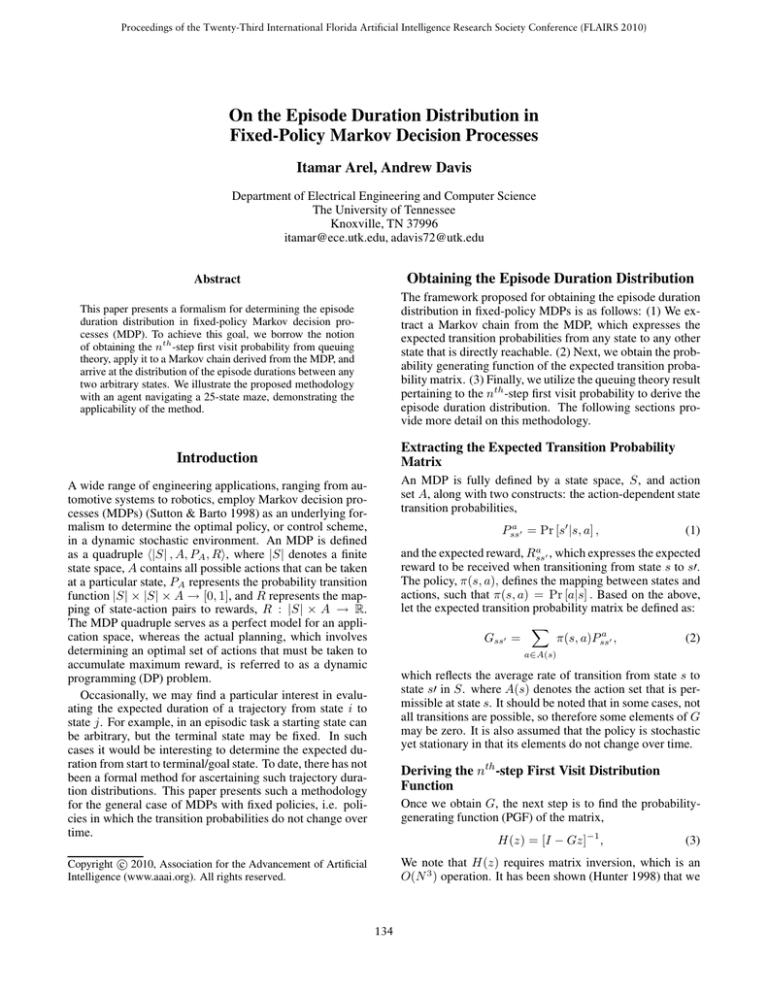
Proceedings of the Twenty-Third International Florida Artificial Intelligence Research Society Conference (FLAIRS 2010)
On the Episode Duration Distribution in
Fixed-Policy Markov Decision Processes
Itamar Arel, Andrew Davis
Department of Electrical Engineering and Computer Science
The University of Tennessee
Knoxville, TN 37996
itamar@ece.utk.edu, adavis72@utk.edu
Abstract
Obtaining the Episode Duration Distribution
This paper presents a formalism for determining the episode
duration distribution in fixed-policy Markov decision processes (MDP). To achieve this goal, we borrow the notion
of obtaining the nth -step first visit probability from queuing
theory, apply it to a Markov chain derived from the MDP, and
arrive at the distribution of the episode durations between any
two arbitrary states. We illustrate the proposed methodology
with an agent navigating a 25-state maze, demonstrating the
applicability of the method.
The framework proposed for obtaining the episode duration
distribution in fixed-policy MDPs is as follows: (1) We extract a Markov chain from the MDP, which expresses the
expected transition probabilities from any state to any other
state that is directly reachable. (2) Next, we obtain the probability generating function of the expected transition probability matrix. (3) Finally, we utilize the queuing theory result
pertaining to the nth -step first visit probability to derive the
episode duration distribution. The following sections provide more detail on this methodology.
Extracting the Expected Transition Probability
Matrix
Introduction
An MDP is fully defined by a state space, S, and action
set A, along with two constructs: the action-dependent state
transition probabilities,
A wide range of engineering applications, ranging from automotive systems to robotics, employ Markov decision processes (MDPs) (Sutton & Barto 1998) as an underlying formalism to determine the optimal policy, or control scheme,
in a dynamic stochastic environment. An MDP is defined
as a quadruple |S| , A, PA , R, where |S| denotes a finite
state space, A contains all possible actions that can be taken
at a particular state, PA represents the probability transition
function |S| × |S| × A → [0, 1], and R represents the mapping of state-action pairs to rewards, R : |S| × A → R.
The MDP quadruple serves as a perfect model for an application space, whereas the actual planning, which involves
determining an optimal set of actions that must be taken to
accumulate maximum reward, is referred to as a dynamic
programming (DP) problem.
Occasionally, we may find a particular interest in evaluating the expected duration of a trajectory from state i to
state j. For example, in an episodic task a starting state can
be arbitrary, but the terminal state may be fixed. In such
cases it would be interesting to determine the expected duration from start to terminal/goal state. To date, there has not
been a formal method for ascertaining such trajectory duration distributions. This paper presents such a methodology
for the general case of MDPs with fixed policies, i.e. policies in which the transition probabilities do not change over
time.
a
Pss
= Pr [s |s, a] ,
(1)
a
and the expected reward, Rss
, which expresses the expected
reward to be received when transitioning from state s to s.
The policy, π(s, a), defines the mapping between states and
actions, such that π(s, a) = Pr [a|s] . Based on the above,
let the expected transition probability matrix be defined as:
a
π(s, a)Pss
(2)
Gss =
,
a∈A(s)
which reflects the average rate of transition from state s to
state s in S. where A(s) denotes the action set that is permissible at state s. It should be noted that in some cases, not
all transitions are possible, so therefore some elements of G
may be zero. It is also assumed that the policy is stochastic
yet stationary in that its elements do not change over time.
Deriving the nth -step First Visit Distribution
Function
Once we obtain G, the next step is to find the probabilitygenerating function (PGF) of the matrix,
H(z) = [I − Gz]−1 ,
(3)
We note that H(z) requires matrix inversion, which is an
O(N 3 ) operation. It has been shown (Hunter 1998) that we
c 2010, Association for the Advancement of Artificial
Copyright Intelligence (www.aaai.org). All rights reserved.
134
can obtain the PGF of an nth -step first transition probability
distribution through the following expression:
F (z) =
Hss (z) − δss
,
Hs s (z)
(4)
where δ denotes the Kronecker delta. Element (s, s) of
the nth -step first transition probability matrix expresses the
likelihood that a transition from state s to state s will occur in precisely n steps. This is the exact interpretation of
episodes, if s is the starting state and s the terminal state.
Thus, the inverse PGF transform on F (z) is expected to
yield the episode duration probability mass function - the
metric which we seek. The relationship between F (z) and
the probability mass function for the episode duration is
F (k) (0)
,
(5)
k!
where F (k) (0) denotes the k th derivative with respect to z
evaluated at zero and k! is k factorial.
f (k) =
Figure 2: “The 25-state Maze Example, cast into a Markov
chain.”
Now that we have the expected transition probability matrix G, we obtain H(z) by applying (3). Next, we must obtain Hss (z) and Hs s (z) by defining the initial state and the
goal state, which will be (1,1) and (5,5), respectively. Applying these two functions to (4) gives us F (z), the PGF of
the probability mass function. Finally, we can apply (5) to
obtain the probability mass function (see Figure 3).
Example
We illustrate the methodology described using simple 25state maze, as illustrated in Figure 1. At each state, four
actions are permissible: Up, Down, Left, and Right. If the
agent chooses an action that results in the collision with a
wall, the agent will remain in the same state.
Episode Duration Distribution
0.05
P(steps)
0.04
0.03
0.02
0.01
0
10
20
30
40
50
60
70
80
90
100
Steps
Figure 3: “The Episode Duration Distribution of the Maze
Example.”
In conclusion, this paper presented a methodology for analytically determining the episode duration distribution of
a Markov decision process. An agent could use the distribution as a simple discriminator between two policies if episode brevity is of utmost importance, the agent could
compare the expected episode duration of two different policies derived from the episode duration distribution. The
agent would then choose the policy with the shorter expected
value. MDPs that offer a reward at the terminal state are
especially applicable to this discriminator, so this methodology could be applied to any problem in this subset of MDPs.
Figure 1: “The 25-state Maze Example, MDP.”
First, we must convert the policy and environment into
a Markov chain. By (2), the probability of moving into a
state’s neighbor is simply the probability that the agent will
take that action. The probability of looping back into the
same state is the sum of the probability of all actions that
would result in a collision with a wall. By evaluating this
simple computation, we now have the MDP of the maze example.
Figure 2 shows the MDP derived from the Markov chain,
where the numbers preceding the arrows transitioning into
the adjacent cells indicate the probability of taking that action, and the numbers in the top left corner of each cell indicate the probability of colliding with a wall and remaining
in that state.
References
Hunter, J. J. 1998. Mathematical Techniques of Applied
Probability: Discrete Time Models: Techniques and Applications, Vol. 2. Academic Press.
Sutton, R. S., and Barto, A. G. 1998. Reinforcement Learning : An Introduction. The MIT Press.
135





